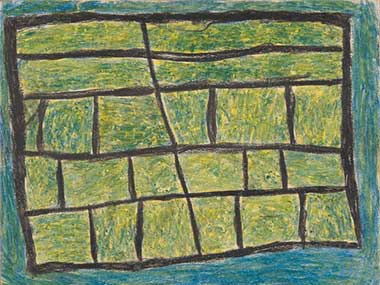Warlpiri Act of Memory

Larry Jungarrayi's famous drawing of 'The Malaka's House' in the Warlpiri Drawings Collection
Jeremy Eccles | 09.02.17
Author: Jeremy Eccles
News source: Press Release
Today, the UNESCO 'Memory of the World' Australian Register has accepted on to a list of just 57-precious items a collection of drawings made by Warlpiri people in the 1950s.
It consists of 169 crayon drawings collected by noted anthropologist Mervyn Meggitt while undertaking fieldwork with Warlpiri people at Lajamanu (Hooker Creek) between 1953 and 1954. The Warlpiri had been forcibly taken from Yuendumu on their own traditional land when it had become overcrowded and moved north to Gurindju country. So the drawings represented an important act of memory of that loss.
In order to facilitate his research into Warlpiri social organisation and the totemic designs associated with Warlpiri Dreamings, Meggitt encouraged men and women to make crayon drawings. The drawings, by 21 men and three women, cover a wide variety of subject matter from ceremonial and cosmological knowledge to desert landscapes and scenes of settlement life, providing insights into the changing world of the Warlpiri. Two of the men whose drawings feature prominently, Larry Jungarrayi and Abe Jangala, subsequently became internationally renowned artists.
Other names among the 21 men and 3 women who contributed but have since disappeared from art history included Silent Jampijinpa, Lucy Nakamara, Annie Nungarrayi and Bulbul Japaljarri. But the most famous work is Larry Jungarrayi's work now know as 'The Malaka's House'. Meggitt at first interpreted this grid-pattern work as an aerial view of rice fields but was mocked by the artist for this misreading. “It's the malaka's house”, he exclaimed, shocked – the key point of difference to the sort of hut he lived in being the defining feature of fly-wires to inure the community's white superintendent from the outside world. Meggitt later admitted, “It's all the windows put together; that's the house. You don't need anything else”.
The drawings are of historic significance as they document the relationship and obligations of the artists to their traditional country across the vast Tanami Desert, shortly after they had been displaced to the new government settlement at Lajamanu in 1948. They predate by two decades the practice of acrylic painting on canvas that emerged at Papunya in the early 1970s (and Yuendumu a decade later) which began the revolution in modern Aboriginal art. The artistic and research significance of the collection was acknowledged in a major exhibition at the National Museum of Australia in 2014-2015, Warlpiri Drawings – Remembering the Future, curated by academic Melinda Hinkson, who also wrote the book of the same name published by Aboriginal Studies Press. Remembering the Future relates to the way the present generation of Warlpiri reacted to studying the drawings.
The collection of drawings, along with original photographs and accompanying audio material featuring Meggitt discussing the drawings, was deposited with AIATSIS in 1965 and officially donated by Meggitt's widow, Joan Meggitt, in 2013. He had destroyed much else of his original research material for fear of it being misinterpreted by others.
Also in the Australian UNESCO Memory of the World Register are the Walter Burley Griffin and Marion Mahony Griffin Designs for Canberra, the Australian Agricultural Company Papers, the Port Phillip Association Records, a Sydney theatre playbill from 1796, and the Yirrkala Drawings – encouraged by Ronald Berndt from Yolngu artists in Arnhemland.
URL: http://www.amw.org.au/register/listings/warlpiri-drawings-1953-54
Share this:
»  del.icio.us
»
del.icio.us
»  Digg it
»
Digg it
»  reddit
»
reddit
»  Google
»
Google
»  StumbleUpon
»
StumbleUpon
»  Technorati
»
Technorati
»  Facebook
Facebook
Contact Details

Abe Jangala's 'Unidentified Country' drawing. Jangala went on to produice many famous 'Water Dreamings'
Further Research
Artists: Abe Jangala | Annie Nungarrayi | Bulbul Japaljarri, | Larry Jungarrayi | Lucy Nakamara | Silent Jampijinpa
News Tags: Jeremy Eccles | Lajamanu | Melinda Hinkson | Memory of the World Register | Mervyn Meggitt | National Museum of Australia | UNESCO | Warlpiri Drawings
News Archive
- 11.10.17 | RETURN OF MUNGO MAN
- 10.10.17 | TARNANTHI 2017
- 11.08.17 | Natsiaas 2017
- 08.08.17 | ABORIGINAL ART ECONOMICS
- 02.08.17 | SCHOLL'S NEXT MOVE
- 20.07.17 | APY ART DOMINATES THE WYNNE
- 17.07.17 | Anangu Artist Wins $100,000 Prize
- 14.07.17 | The End of AAMU
- 13.07.17 | YOU ARE HERE
- 11.07.17 | ART ACROSS THE COUNTRY
- 11.07.17 | TARNANTHI IN OCTOBER
- 05.07.17 | TJUNGUṈUTJA - from having come together
- 02.07.17 | BENNELONG
- 27.06.17 | JIMMY CHI
- 23.06.17 | Blak Markets at Barangaroo
Advertising

